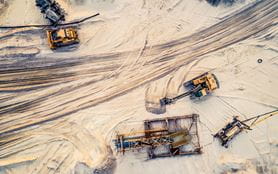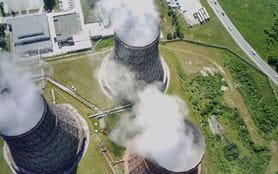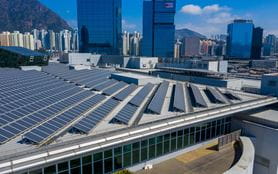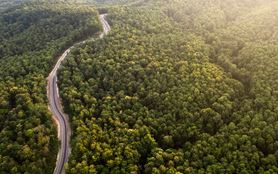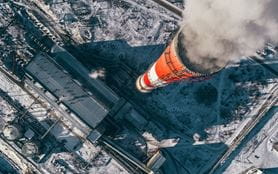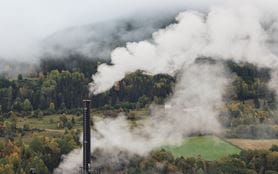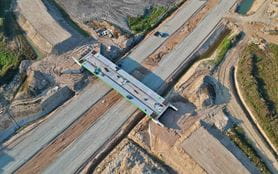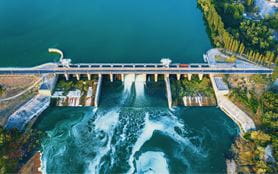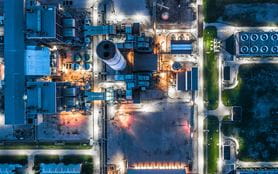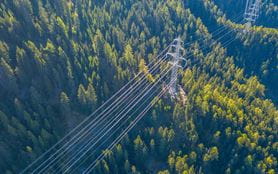Financing the gap: a blueprint for decarbonisation
Related people




David Lee
Partner
London

Scott Neilson
Partner
Tokyo

Matthew Townsend
Partner, Global Co-Head Environment, Climate and Regulatory Law Group and the International Trade Group
London

Anna Masser
Partner
Frankfurt am Main

Ken Rivlin
Partner, Global Co-Head Environment, Climate and Regulatory Law Group and the International Trade Group
New York

Sally Dewar
CEO, A&O Consulting
London

Gauthier van Thuyne
Partner
Brussels

Kate Sumpter
Partner
London

Bob Penn
Partner
London

George Cannon
Partner
Washington, D.C.

Goran Galic
Partner
Perth
Headlines in this article
Delivering Net Zero by 2050 will involve massive investment in physical assets and innovation, and mobilising that capital will require major regulatory and market reform. “Financing the gap” is our contribution to this critical goal. Here, we explore the dynamics shaping global energy markets and the challenges of transitioning to a low-carbon economy. We also identify 16 ways to accelerate the shift, from reforming corporate governance rules to reducing the liability risks around carbon capture, utilisation and storage.
The Net Zero challenge
Despite greenhouse gas (GHG) emissions continuing to rise – and “irrefutable evidence” those emissions are having a catastrophic effect on the environment – progress on more ambitious climate targets has stalled.
In order to meet the objective of the Paris Agreement and keep global temperature rises below 1.5C, our atmosphere can absorb no more than 400 additional gigatonnes of CO2.
At today’s run rates this "carbon budget" will be exhausted by 2030. It is therefore essential that emissions are cut drastically over the next decade, with the UN estimating a 45% reduction is needed by 2030 to keep 1.5C within reach.
However, it is possible the current energy crisis will result in even higher carbon outputs as Paris signatories backslide on their commitments in a bid to keep the lights on.
Decarbonisation will require unprecedented cooperation between the public and private sectors, among governments, citizens and NGOs – and among nations with different priorities.
As a result, work to develop the low-carbon infrastructure we will need at scale beyond 2030 – such as nuclear power and possibly hydrogen – must happen now.
Maximum effort must also be applied to things that can make an immediate impact, such as renewables, electric vehicles, energy efficiency measures, grid upgrades and reducing consumption.
Decarbonising the global economy will involve unprecedented cooperation between the public and private sectors, among governments, citizens and NGOs, and among nations with vastly different priorities.
It will require transformational policy and regulation to unlock private investment in renewable infrastructure and green innovation.
And if that was not enough, it will be made more difficult by the short-term need for governments to address the immediate challenges of energy security and rising inflation, both of which have the potential to delay the difficult decisions that lie ahead.
Greater clarity needed over directors' duties and sustainability
The forces shaping global energy markets
Energy use contributes almost three-quarters (73.1%) of global emissions. Any exploration of how to deliver Net Zero therefore has to consider the major trends shaping global energy markets.
The first is decarbonisation itself, through which the most carbon-intensive methods of energy production (eg burning coal to generate power) are switched for cleaner alternatives (eg gas and renewables), and the use of hydrocarbons for transportation and storage gives way to electricity, batteries and/or hydrogen and ammonia.
Decarbonisation in six charts
The visualisations below explain the Net Zero challenge. Click through using the arrow in the top right.
At the same time, work is ongoing to scale carbon capture, utilisation and storage (CCUS), which has the potential to remove GHGs from hard-to-abate industrial processes such as steel, chemicals and cement production.
The technology is available, but is challenged by the fact that the cost to capture carbon has to be less than the cost to emit it. In most countries, the latter is negligible – or non-existent.
Action on liability risks vital for uptake of carbon capture and storage – read more.
Carbon capture, utilisation and storage explained
Carbon capture, utilisation and storage (CCUS) refers to a range of technologies designed to remove the CO2 released by carbon-intensive activities, which can then either be sequestered in the ground – for example in the same subterranean reservoirs from which fossil fuels are extracted – or used in other industrial processes.
CCUS technologies have been in development for some time and governments are starting to offer significant incentives for private-sector involvement, including tax breaks, subsidies and other guarantees.
Major carbon storage projects have already started in countries such as Australia, China and Norway. In the United States, the Inflation Reduction Act provides significant financial support for carbon capture, although the landscape for storage permits is more challenging.
Transitioning to low-carbon power is not a straightforward process. While the marginal cost of electricity from some renewables is lower than from fossil fuels (because the inputs – wind, sunlight, the movement of water – are free), the cost of developing the necessary infrastructure is high (because the systems must be “overbuilt” to deliver the same output).
Governments also have to ensure they have enough power to meet demand, putting intermittent sources such as wind and solar at a disadvantage relative to, say, gas, which has a high “capacity factor” (ie gas-fired power stations can run almost all the time).
The world needs a robust international carbon market – read more.
The uneven impact of coal-fired power
Then there is the issue of existing infrastructure. The typical coal-fired power plant in the developed world is between 30 and 40 years old, putting it close to the end of its operational life (the average coal facility is decommissioned after 46 years).
This means it is easier for governments in the West to remove coal from their energy mix than it is for their counterparts in Asia, where almost 50% of primary energy comes from coal and the average coal-fired plant is just 13 years old.
These facilities have long remaining lives, so will not quickly come offline without a major market shift. Indonesia’s state-owned power utility for example has announced plans to decommission all its coal-fired plants by 2056, 18 years later than Germany, 26 years later than Spain and 32 years later than France.
Here, some of the innovative structures developed by multilateral financing institutions offer hope, although whether they can be scaled quickly enough to make a meaningful impact on emissions remains to be seen.
West has responsibility to deliver a ‘just’ energy transition – read more.
How can Asia switch to lower-carbon fuels?
There are also ways to reduce the carbon intensity of coal-fired energy production, for example by converting coal-fired facilities to run on a mix of coal and ammonia, which is rich in hydrogen and produces only nitrogen and water as by-products.
Coal-fired facilities have long remaining lives and continue to be built in some countries – so will not quickly come offline without a major market shift.
Another way is to replace or retrofit them with gas- or biomass-fired turbines. Switching from coal to gas cuts carbon emissions by between 40 and 50%, but Russia’s invasion of Ukraine has sent gas prices soaring. The bigger challenge to Net Zero is that new plants continue to be built in some countries, running counter to the UN’s warning against the development of any new fossil fuel infrastructure in order to stay within acceptable temperature limits.
Is Asia ready to embrace carbon capture and storage? – read more.
Whether nuclear is a realistic option for Asia (outside of China, South Korea, Japan, India, Pakistan and Bangladesh) over the next decade is also in question. Many countries across Southeast Asia for example do not have a legal regime to share liability for an accident between suppliers, operators and the host and neighbouring states.
Some nuclear plants can also take a long time to build (not least because of the tendency for governments to develop their own safety and permitting requirements, extending construction timelines) and require significant upfront investment.
Renewable energy - pros and cons
| Source | Pros | Cons |
|---|---|---|
|
Solar |
Government subsidies (eg feed-in tariffs) have allowed solar to scale As a result, solar is now the “cheapest energy in history”, according to the International Energy Agency (IEA) Quick and easy to install on existing infrastructure |
Output cannot be adjusted on demand, requiring overbuild of generating capacity and investment in storage Significant physical area needed to generate power at scale Solar plants are distributed across countries; power grids typically radiate from existing power plants near cities Converting solar energy to electricity is inefficient, and unlikely to become much more efficient due to limits of technology Photovoltaic cells are often made of non-renewable materials and have a limited lifespan, without economical recycling |
|
Wind |
Again, subsidies such as contracts for difference have enabled wind to scale Price of wind power has therefore been falling in recent years |
Not available on demand Windiest areas tend to be remote (eg offshore or away from population centres), making construction and transporting power back to grid a challenge Inefficient to convert wind to electricity |
|
Nuclear |
Good for baseload power – can be operational >90% of the time and scaled on demand One of the lowest carbon outputs of any energy source |
Nuclear plants require significant capital investment and can take a long time to build Public fears around waste and potential for accidents need to be addressed Different regulatory standards between countries makes innovation difficult |
| Hydrogen |
Most abundant element in the universe; only molecule used as fuel that does not contain carbon Can be used as both an energy source and an energy carrier like electricity (ie can store and transport energy from other sources) |
Different methods of producing hydrogen can contribute to GHG emissions, and hydrogen leakage may exacerbate climate change “Green” hydrogen (the cleanest form, produced by using renewable energy to power electrolysers that split water into hydrogen and oxygen) is expensive. Electrolysers required need to be developed at scale to cut costs Hydrogen production uses more energy than it generates Hydrogen itself is volatile, and hydrogen molecules are so small they can escape from natural gas pipelines. However ammonia, produced from hydrogen and nitrogen, is cheaper and easier to store and transport Larger volumes of hydrogen are needed to produce the same energy output as natural gas |
Governments focus on energy security
This points to a second key energy market theme, security of supply (defined by the International Energy Agency as “uninterrupted availability of energy sources at an affordable price”). Here, the war in Ukraine has fundamentally changed the landscape.
Buyers looking to replace Russian energy have reinvigorated the liquefied natural gas (LNG) industry, where the last of the LNG projects without CCUS should reach the financial investment decision (FID) stage over the next five years.
The countries most reliant on Russian supplies – Germany and Italy – have turned to coal to fill the immediate gap, while underground gas storage tanks have been filled. Longer term however, the crisis is expected to accelerate the transition to lower-carbon power. Europe is channelling more investment into green energy, while Japan’s Prime Minister, Fumio Kishida, has restarted his country’s nuclear programme a decade after it was mothballed in the wake of Fukushima.
How to increase investment in next generation nuclear power – read more.
Renewables have been at the heart of the energy security debate for some time. Vietnam for example has spent many years building out its hydropower resources to the point where hydro now generates more than 25% of its electricity. Further renewable capacity is being added via significant investments in wind and solar.
Vietnam is a good example of the benefits of policy certainty, even in a centralised system with energy monopolies (which typically do not create the best conditions for change).
That said, Vietnam’s grid still contains a significant proportion of coal-fired power, and the Vietnamese government has not yet released its Power Development Plan 8, which would further incentivise renewables and accelerate the transition from coal to gas.
Multilaterals hold key to Net Zero transition in developing world – read more.
The drive to improve energy security is also boosting investment in supply chains as countries shift away from globalised, just-in-time networks. For example, the U.S. is spending $500m to help domestic companies build solar factories in India.
This “friendshoring” – strengthening supply chains for strategic allies – aims to reduce America’s reliance on China. This rewiring of the global system and recalibration of geoeconomic competition will eventually add redundancy to the energy system, which could increase the overall cost of power but reduce price volatility.
Why ‘change of law’ risk threatens Net Zero
The third major trend influencing energy markets is the threat of public policy inaction giving way to rapid shifts in legislation and/or regulation. This “change of law” risk makes it harder for private sector organisations to make financial investment decisions.
U.S. Inflation Reduction Act takes climate change out of political cycle – read more.
Many private investors will only commit capital once legislation has been passed and they can calculate their expected returns with minimal legal uncertainty. Here, government hesitancy represents too big a risk, given the potential for any new policy to go against them (for example by favouring nuclear, leaving renewable facilities stranded).
Policy uncertainty in developing countries is driving international capital towards developed markets, even though bolder action would ease pressure on less wealthy governments.
By contrast, other investors may see an opportunity in acting before a change in law, looking for the most attractive economics on a country-by-country basis and balancing this with their knowledge of the jurisdiction concerned. Their reasoning is that once new infrastructure has been built, the legal change will follow.
We need a new approach to education to shift the energy debate – read more.
Policy uncertainty in the developing world is driving international capital towards developed markets. According to the IEA’s 2022 Southeast Asia Energy Outlook, private capital comprised almost 60% of spending on low-carbon power in Southeast Asia between 2016 and 2020, far below the 90% seen in the West.
Policy inaction not only makes it harder for governments to decarbonise their economies at the same time as they tackle rising inflation, mitigate the effects of climate change and invest in health and education, it is also politically risky.
Any lag in policy can drive a wedge between governments and organisations with Net Zero targets, particularly if they are science-based.
Companies – seeking a commercial advantage from their environmental credentials – may start to influence the public directly by promoting their green commitments, products and services.
NGOs may also step in to the policy void by seeking to educate society on the issues at play, driving more people to care and begin agitating for a change in the law – and possibly voting for a change of government.
Electricity markets must be redesigned for our new reality – read more.
In a world with an entrenched energy system that is 80% reliant on fossil fuels, the Net Zero transition cannot be delivered without government support. Ultimately, policy must work across sectors to drive structural change, for example through carbon pricing or the creation of mandatory carbon markets which level the playing field between fossil fuels and low-emissions alternatives.
Policymakers focus on incentives over obligations
Rather than simply mandating industries to reduce their GHG outputs, policymakers have long tried to use markets to accelerate progress. The signing of the Paris Agreement in 2015 and a change in tone from central banks unleashed a tidal wave of regulation designed to channel private capital towards climate-enhancing activities.
Since then, we have seen the rise of green taxonomies and a focus on corporate sustainability disclosure, both of which are critical to help investors and asset managers make better decisions and for businesses to articulate their environmental credentials.
Decarbonising transportation requires collaboration and regulatory reform – read more.
An alphabet soup of disclosure frameworks have been introduced, including the EU’s Sustainable Finance Reporting Directive (SFDR) and upcoming Corporate Sustainability Reporting Directive (CSRDF), and rules from the Task-Force on Climate-Related Financial Disclosures (TCFD), the Sustainability Accounting Standards Board (SASB), and stock exchanges around the world.
While many of these transparency regimes started out as voluntary, major companies in the UK and France are now subject to mandatory reporting requirements, with the EU and U.S. considering similar measures.
Work under way to harmonise disclosure regimes
In a bid to enable stakeholders to compare company performance, bodies such as the Securities and Exchange Commission (SEC) and the International Sustainability Standards Board (ISSB) are pushing to harmonise the plethora of international reporting standards. There are now so many frameworks out there that this work is essential to accelerate decarbonisation.
Enhanced terms can increase appetite for sustainability-linked bonds – read more.
We are also seeing a rise in regulatory investigations into allegations of greenwashing, putting pressure on financial institutions, asset managers and pension fund trustees over whether their activities are genuinely green.
NGOs are launching headline-grabbing lawsuits over alleged inconsistencies in corporate disclosures and targeting companies without robust, measurable implementation strategies in place to deliver their Net Zero targets. Although designed to accelerate decarbonisation, some institutions are reconsidering their involvement in high-profile climate initiatives over their increasingly stringent disclosure regimes and the associated threat of litigation.
How companies generate sustainability data in a way that minimises risk is critical. With such an intense focus on Net Zero, even the most sophisticated organisations need to navigate the landscape with care.
Against this backdrop – skewed incentives for decarbonisation, global policy uncertainty, pressure on security of supply and a more complex risk environment for business – how can we accelerate the Net Zero transition? We identify 17 steps we believe can make the biggest difference. Explore the series below or download the full PDF.


